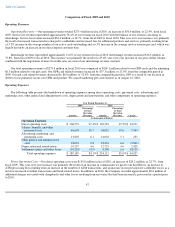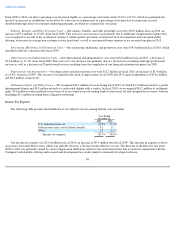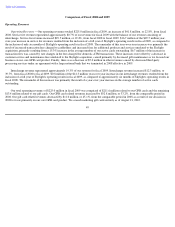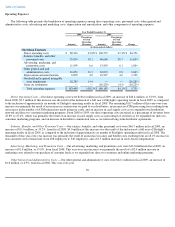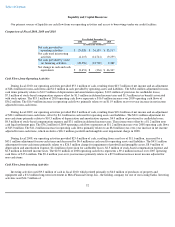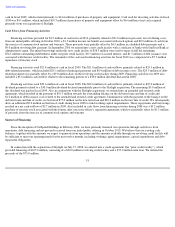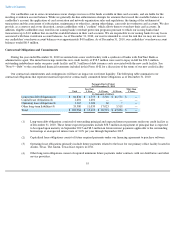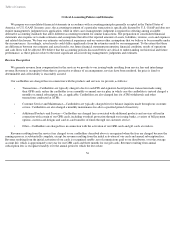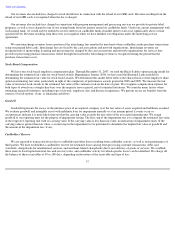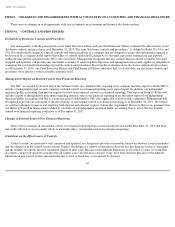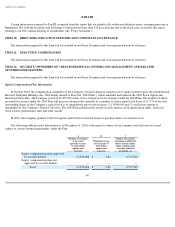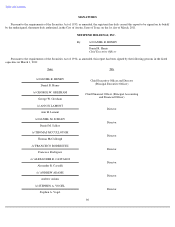NetSpend 2010 Annual Report Download - page 61
Download and view the complete annual report
Please find page 61 of the 2010 NetSpend annual report below. You can navigate through the pages in the report by either clicking on the pages listed below, or by using the keyword search tool below to find specific information within the annual report.
Table of Contents
Our revenues also include fees charged to retail distributors in connection with the reload of our GPR cards. Revenue resulting from the
reload of our GPR cards is recognized when the fee is charged.
Our revenues also include fees charged in connection with program management and processing services we provide for private-label
programs, as well as fees charged to one of our issuing banks based on interest earned on cardholder funds. Under our current arrangement with
such issuing bank, we would only be entitled to receive interest on cardholder funds if market interest rates rose significantly above certain
specified levels. Revenue resulting from these fees is recognized when we have fulfilled our obligations under the underlying service
agreements.
We earn interchange revenues from a portion of the interchange fees remitted by merchants when cardholders make purchase transactions
using our prepaid debit cards. Interchange fees are fixed by the card associations and network organizations. Interchange revenues are
recognized net of sponsorship, licensing and processing fees charged by the card associations and network organizations for services they
provide in processing purchase transactions routed through their networks. Interchange revenue is recognized during the period that the
purchase transactions occur.
Stock
-Based Compensation
We have one stock-based employee compensation plan. Through December 31, 2007, we used the Black-
Scholes option pricing model for
determining the estimated fair value for stock-based awards. Beginning in January 2008, we have used the Binomial Lattice model for
determining the estimated fair value for stock-based awards. We determined this model better reflects the characteristics of the employee share
option in estimating fair value, particularly in light of the complexity of performance awards granted in 2008 and 2009. We measure the fair
value of restricted stock awards at the estimated fair value of the common stock on the date of grant. We recognize compensation expense for
both types of awards on a straight-line basis over the requisite service period, net of estimated forfeitures. We consider many factors when
estimating expected forfeitures, including types of awards, employee class and historical experience. We present excess tax benefits from the
exercise of stock options, if any, as financing cash flows.
Goodwill
Goodwill represents the excess of the purchase price of an acquired company over the fair value of assets acquired and liabilities assumed.
We evaluate goodwill and intangible assets with indefinite lives for impairment annually or at an interim period if events occur or
circumstances indicate it is more likely than not that the carrying value exceeds the fair value of the associated reporting unit. We assign
goodwill to our reporting units for the purpose of impairment testing. The first step of the impairment test is to compare the estimated fair value
of the respective reporting unit with its carrying value. If the carrying value is less than fair value, no indication of impairment exists. If the
carrying value is greater than fair value, a second step in the impairment test is performed to determine the implied fair value of goodwill and
the amount of the impairment loss, if any.
Cardholders' Reserve
We are exposed to transaction losses due to cardholder and other losses resulting from cardholder activity, as well as non-performance of
third parties. We have established a cardholders' reserve for estimated losses arising from processing customer transactions, debit card
overdrafts, chargebacks for unauthorized card use, and merchant-related chargebacks due to non-delivery of goods or services. We establish
these reserves based upon historical loss and recovery rates, and cardholder activity for which specific losses can be identified. We charge off
the balance of these receivables at 90 or 180 days, depending on the nature of the receivable and type of loss.
57


